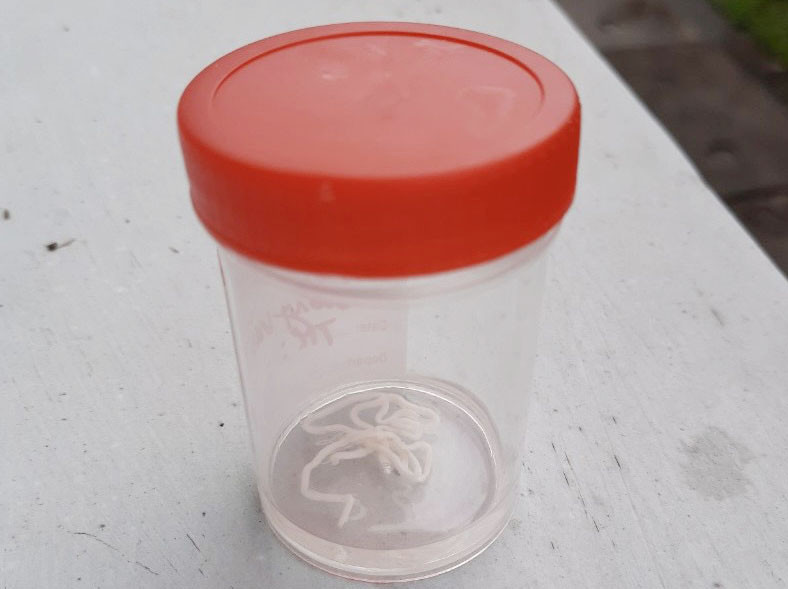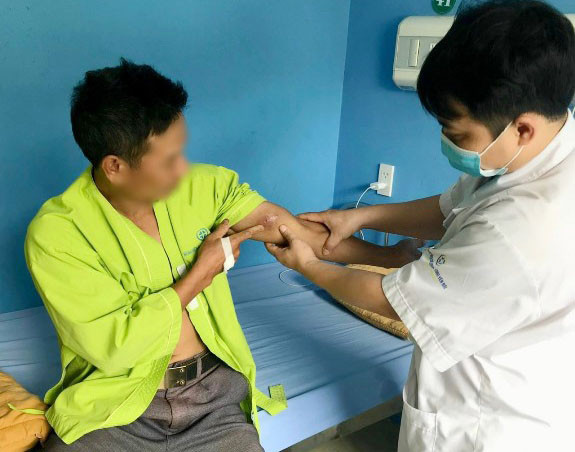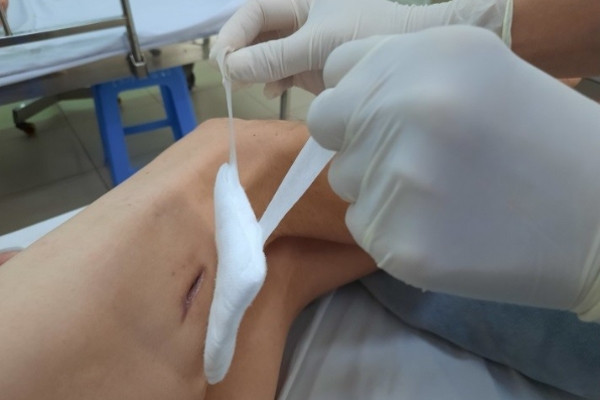Dragon worm 8cm long pulled from the hand of a man who likes to eat fish salad
Yen Bai Provincial General Hospital has just received a male patient (42 years old living in Ngoc Chan commune, Yen Binh district) infected with dragonworm disease.
The patient has a history of drinking water from streams, eating fish salad… and has not been dewormed for many years. A month ago, he had lumpy swelling in his chest, arm, and left thigh. Recently, the swelling part broke, oozing pus, pulled out 2 worms about 7-8cm long. On June 6, the patient went to Yen Bai Provincial General Hospital for examination in a state of consciousness, no fever, no vomiting, difficulty breathing, swelling in the chest, left arm and left thigh, pain and bleeding. pus.

The ultrasound showed that the subcutaneous tissue in the chest wall had several scattered hypoechoic foci, a large volume of 35x12mm, the area from the left hand at the ultrasound site had a 9x3mm sounder, and the back of the left thigh had a hypoechoic socket. size 7x4mm.
The patient was diagnosed with dragon worm infection (Dracunculus), the doctors cleaned, removed all the worms, and used the antibiotic Metronidazol to treat superinfection of the ulcer. Currently, this man is awake, in good health, being monitored and continues to receive treatment.
Dragonworm disease, scientifically known as Dracunculus medinensis, causes disease in humans and animals. The disease is transmitted through the gastrointestinal tract and enters the body through drinking water or food such as rare, live aquatic animals (fish, frogs, frogs, shrimp…) containing dragonworm larvae. Anyone of any age can be infected, and the incidence can be as high as 60%.

The incubation period lasts 9-14 months and progresses silently, rarely causing direct death, but can be fatal due to complications of the disease such as secondary infection, cold abscess appearing at the site of death, infection with worms. coincident…) paralysis of the spinal cord, hemiplegia due to dead worms and calcification.
Signs of dragon worm disease
When the disease is first detected, there are usually no special symptoms. About 1 year later, when the female worms begin to move and develop in the subcutaneous tissues, the patient may have the following signs: Low fever, dizziness, vomiting, nausea, diarrhea, redness, numbness and itching at the site where the worms are located.
In the next few days, the swelling bursts and secretes yellow fluid, at the lesion site, a white worm is found from the inside out (usually the head of the worm), if there is no impact, the worm will usually die on its own. come out completely after 3-6 weeks.
In some cases, the patient pulls himself, but if he breaks it halfway, it will cause the worm larvae and the toxins released to spread along the worm’s path, making the infection worse, more severe, and can lead to other infections. complications such as sepsis, ankylosing spondylitis, abscesses caused by worms die before excreting worm larvae or tetanus.
Treatment of dragonworm disease
When you see the worms coming out of the swelling, use a round stick and then roll it slowly to pull all the worms out (do not hold the scissors or prick the wound to get the worms out).
Treatment with mebendazole or thiabendazole; use more antibiotics, pain relief, anti-edema.
Soak the affected area in warm water to stimulate the worms to come out. After soaking the lesions, sprinkle with lime powder, or Chloramin B before being discharged into the environment.
Prevention of dragon worm disease
People need to perform well the work of food hygiene and safety: eat cooked, drink boiled; Use separate utensils for processing cooked and raw foods (cutting boards, knives, blenders, bowls, plates, etc.), especially hand hygiene after handling raw foods.
Cook thoroughly when using aquatic foods (frogs, fish, shrimp…), bury or burn, sprinkle with lime powder for the intestines, head… after processing to limit the spread of infection. The family also does not let dogs and cats eat raw aquatic foods (frogs, fish, shrimp…).
Patients who are in the advanced stage of Guinea disease should not bathe, wash in ponds or other domestic water sources to avoid spreading larvae into the environment. The patient cleans the wound, regularly bandages the affected area until the worm is completely removed from the body.
Phuong Le

at Blogtuan.info – Source: vietnamnet.vn – Read the original article here



